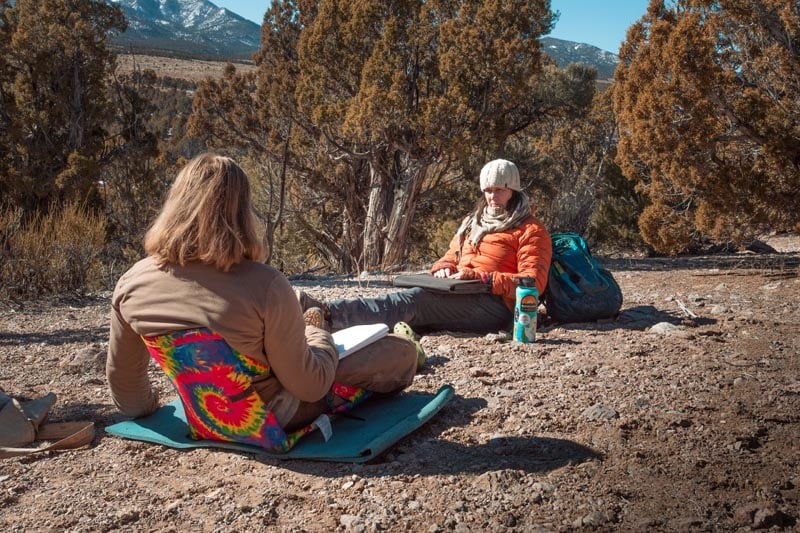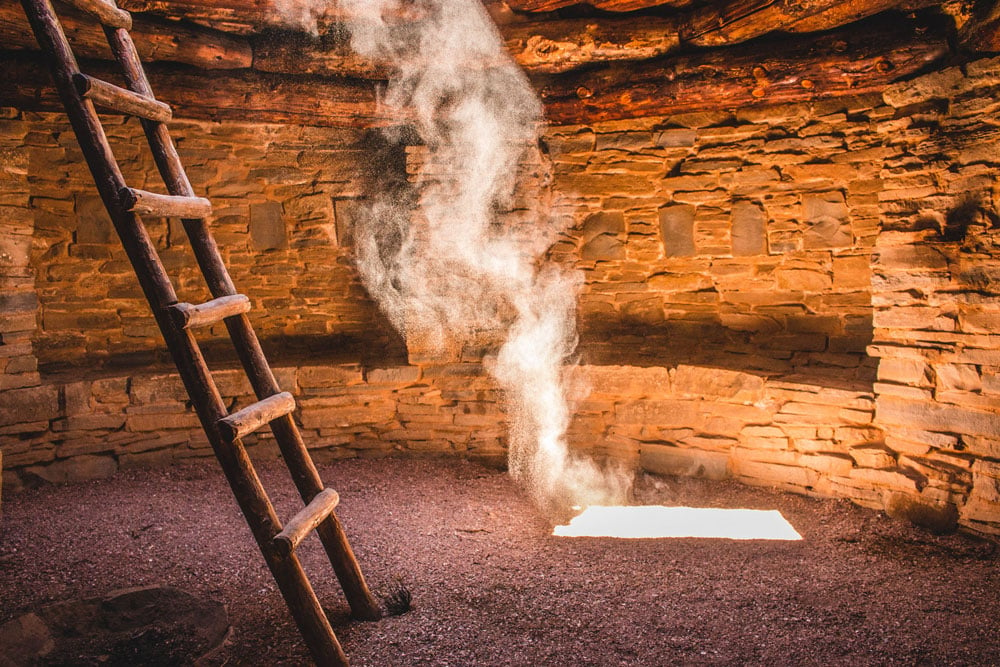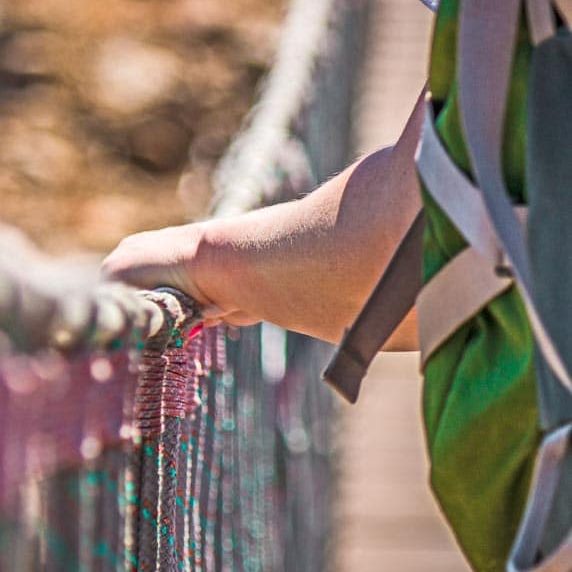
Parenting an anxious teenager has many challenges that can overwhelm any parent or guardian. You are not alone in this struggle. Many parents are finding themselves in this stressful situation. In fact, according to the National Institutes of Health, nearly 1 in 3 of all adolescents ages 13 to 18 will experience an anxiety disorder. The number of anxious teenagers is also on the rise. It is a sad fact, but you should know that you are not alone. Many others are parenting anxious teens. They, too, are struggling to help their child overcome a disorder that is taking over their lives.
First, let’s learn about what you and your family are up against. We will then go over the symptoms of an anxiety disorder (some may surprise you) and learn about co-occurring conditions like depression. Most importantly, we will go over ways to help your child, so they can start living their best life.
How Does Anxiety Affect Teens?
- Recurring intrusive thoughts or concerns
- Difficulty concentrating
- Worries about everyday life events
- Fear of dying
- Fear of going crazy
- Excessive concern about being harmed
- Worrying about loved ones
- Avoidance of independent activities
- Fear of unfamiliar people
- Low Self-Esteem
- Experiencing excessive fears and worries
- An anxiety disorder can affect every aspect of a teen’s life, including:
- School Attendance
- Grades
- Sleep
- Hobbies
- Commitments to sports or clubs
- Friendships
- Dating
- Relationships with family
- Self-worth
- Physical health
- Co-occurring conditions
Anxiety presents in many different ways and can affect each person differently. Because anxiety can cause gradual changes in your teen’s life, it can be difficult for parents to understand exactly what is going on. For instance, it is hard for parents to know whether their anxious teen is not hanging out with their friends because of social anxiety or just because some friends can drift apart. Similarly, parents can struggle to understand the reasons why they can’t sleep. Are they drinking too much caffeine, or are they up all night rehearsing conversations in their head because they are scared to say the wrong thing?
It can also be challenging for a young person to understand how anyone can help them with their anxiety. Teens might not understand how to communicate their feelings. They might not even think that they are normal, despite the fact that many teens are struggling with anxiety.
How Common is Anxiety in Teens?
Many parents wonder, “Is it normal for my teenager to have anxiety?”
Anxiety disorders are the most common mental health disorder for teens and children. Many different studies have taken a closer look at anxiety in teens. Depending on which study you read, they estimate 15-30 percent of young people will be diagnosed with an anxiety disorder before 18. Unfortunately, many more go undiagnosed, but experience the adverse effects nonetheless.
As parents, one of the best ways to help your child is to bring awareness to the issue of anxiety in young people. The earlier your child is diagnosed, the sooner they will benefit from the many available treatments. But how do you know if your child has an anxiety disorder? First, let’s look at the many different symptoms from the many various anxiety disorders.
Feeling anxious sometimes is normal, like when you are nervous about passing a test. That nervousness or stress can even help people stay motivated when studying. It is built into our biology and allows us to react to threats or danger (think the fight, flight, or freeze response). Good anxiety is proportional, though. It does not last long and is an appropriate response for the situation.
When someone develops an anxiety disorder, the anxious feeling is no longer acting as a tool to help get through stressful situations. Instead, the anxiety leads to excessive worry or fear. This can negatively impact everyday activities and even how someone interacts with the world for an extended time.
Teenage Anxiety Statistics
- Anxiety disorders are the most common mental illness in the U.S.
- Anxiety is more common among women and caregivers.
- 80% of kids with a diagnosable anxiety disorder are not getting treatment, and anxiety disorders are highly treatable!
- Studies have found a combination of cognitive-behavioral therapy (CBT) and medication for 12 weeks yields a positive response in 80% of children with anxiety disorders.
- About 50 percent of adults and up to 30 percent of children with ADHD also have an anxiety disorder.
What Causes Anxiety in Teens?
Teenagers are under much pressure today. They are trying to balance more than previous generations. Excess amounts of screen time have been normalized. Depending on what research study you read, screens are now occupying 4-6 hours each day of a teen’s life. Social media use alone has been linked to increased anxiety and depression in teens.
Additionally, environmental factors can be responsible for increased anxiety in teens.
Unfortunately, many teenagers have not developed sound coping skills for the stressors that can greatly impact their mental health.
Many of these factors can cascade onto each other. One can lead to another, and before your teenager knows it, they are stuck in their anxiety. The cycle can continue as teens try to escape the anxious feelings, and co-occurring conditions can arise.

Feeling anxiety about being anxious is a typical feedback loop
- Environmental Factors
- Death of a loved one
- Trauma
- Bullying
- Divorce
- Other Factors
- Family history of anxiety
- Social isolation
- Conflict
- Health issues
- Financial hardship
- Sleep disturbances
- Increased caffeine intake
If your teenager shows signs of any of the issues, it is important to consider the root cause of the problem before taking the next step.
Symptoms of Anxiety in Teens
Physical Symptoms
- Fast heartbeat
- Rapid breathing or difficulty breathing
- Sweating
- Restlessness
- Frequent headaches and migraines
- Upset stomach & Indigestion
- Unexplained aches and pains
- Chest pain
- Muscle tension
- Trembling
- Dry mouth
- Not feeling well with no apparent medical cause
Social Symptoms
- Changes in social behavior
- Withdrawal from social activity
- Avoiding social interactions
- Avoiding extracurricular activities
- Spending increased time alone
- Avoidance of new situations
- Unstable social relations
Behavioral Symptoms
- Mood swings
- Irritability
- Unexplained outbursts
- Changes in eating habits
- Repeated reassurance-seeking
- Substance use
- Extreme self-consciousness
Changes In Sleep Patterns
- Difficulty falling asleep
- Difficulty staying asleep
- Frequent nightmares
- Not feeling rested after sleeping
Anxiety & Academics
- Poor school performance
- Overwhelmed by the workload
- Frequently missed assignments
- Missing school
- Drop in grades or school refusal
- Avoidance and fear of school-related events
- Difficulties with family functioning
Symptoms of Phobias & Panic Attacks
- Avoidance and distress of a feared object
- Tachycardia (fast heartbeat)
- Syncope
- Throat tightness
- Accelerated heart rate
- Issues with breathing
- Feeling like they’re dying
- Feeling like they’re “going crazy.”
- Numbness or tingling in arms and legs
- Difficulties breathing
- Intense fears
- Lightheaded
- Shortness of breath
- Shaking
- Sense of unreality
- Fear of dying, or losing their mind
Less Common Symptoms of Anxiety
- Tinnitus
- Excessive yawning
- Tremors
- Tics
- Derealization
- Cold Extremities
- Globus Hystericus -(lump in the throat feeling)
The Different Types of Anxiety Disorders in Teens and How to Recognize Them
It is easy to think of teenagers as “immature adults,” but the truth is that they are not. Your teenager will most likely not show the same symptoms as an adult who has severe anxiety. Symptoms also depend on the type of anxiety disorder a teen has. There isn’t just one kind. To further understand the different types of anxiety disorders, let’s examine each one.
You Are Not Alone
RedCliff Ascent is there for you and your family.
How can you Recognize Social Anxiety in Teenagers?
Social Anxiety Disorder is a mental health condition where irrational anxiety is caused by social interactions or events. Adverse experiences like bullying can cause teen anxiety. Teenagers who have social anxiety disorder can excessively worry or have a social phobia. They worry about things like being embarrassed or judged. This often leads people with social anxiety to try to avoid many social situations. They may show physical signs like excessive sweating, fast heart rate, and nausea when experiencing anxious feelings.

Other Forms of Anxiety Disorders That Can Be Affecting Your Child’s Mental Health
Common Co-Occurring Conditions
Being anxious is an uncomfortable feeling. In response, co-occurring conditions are often present. Let’s take a look at the most common co-occurring conditions for teens who have anxiety.
How Do You Help a Teenager With Anxiety?
As a parent, you want the very best for your child. However, it can be hard to help a teenager through struggles with anxiety. Teens might not understand how their anxiety is affecting themselves or others. Anxiety is known as one of many internalizing disorders and is fundamentally an internal battle. Your teenager might not remember what it is like to not live with anxiety, as symptoms can often appear at a young age. The first step in the right direction is identifying the problem or awareness that there is an issue.
Once identified, teens can start working on lifestyle changes to begin calming some of their anxious feelings. There are many treatment options available for teens. There are also many medication options. Overall, anxiety is treatable with individualized plans that fit your child’s needs.
What Lifestyle Changes Help Alleviate Anxiety in Teens?
Some of the best medicine is right in front of us! Overall, balance and wellness can help teens get back on track. Remember that lifestyle changes can make a big difference. On the other hand, they are not a replacement for treatment. The lifestyle changes below are great things to try alongside professional recommendations. Take a look at all the things you can encourage or role model your teen to help with their anxiety.
Diet
It is no big surprise that what people eat affects their mood. Quick carbs like doughnuts and chips are delicious and convenient. Unfortunately, they spike blood sugar and then crash. Eating a healthy diet can help regulate and increase overall mood.
Exercise
Exercise releases endorphins and helps to reduce stress.
Reduce Caffeine Intake
Not many people can go without a warm cup of coffee in the morning, and there are some great health benefits linked to drinking it! However, when people do not drink caffeinated beverages in moderation, it can make anxiety worse. Caffeine disrupts sleep patterns and increases the consumption of empty calories. Teens or anyone who drinks caffeine in moderation will feel less anxious and more rested.
Mindfulness
Mindfulness is a great way to combat anxiety. Many studies have been conducted and confirmed that mindfulness exercises like yoga, meditation, or breathing exercises reduce anxiety and stress.
Sleep Habits
People need sleep, and we need a lot of it. If your teenager is struggling to sleep, they can do several behavioral things to help them fall asleep and stay asleep.
- Stick to a routine
- Limit caffeine and only drink caffeine in the morning.
- Stop using electronics at least 30 mins before going to bed.
- Get enough exercise
- Try deep breathing or relaxation exercises.
- Stop eating 1-3 hours before going to bed
How is Drug Therapy Used to Treat Anxiety in Teens?
There is no such thing as a happy pill, but medications for teens can help them with their anxiety. For best results, anxiety medication is used in conjunction with other therapeutic modalities.
Antidepressant medications are most commonly used in treating anxiety in teens. Before your child takes an antidepressant or any psychiatric medication, it is essential to have an in-depth discussion with your child’s doctor to fully understand what to expect.
Questions to Ask Your Child's Healthcare Provider
Why Do You Recommend That Specific Drug?
There are many reasons why a doctor would prescribe a particular medication. They factor in the child’s age, symptoms, and potential side effects.
What Are the Expected Side Effects?
Antidepressants often have side effects, especially at first. Ask your doctor about them and if there are any that you will need to be particularly aware of.
What is the Desired Outcome?
Everyone’s treatment goals are unique to each individual, and it is essential to have realistic expectations for treatment. Getting the proper medication can take time with some trial and error. It can be a frustrating process, but it is well worth the effort when your child can get the help they need to overcome anxiety and start living the life they deserve.
Treatment Options For Teens With Anxiety
There are many treatment options available for teens who are struggling with anxiety. Best results for teenagers usually involve a combination of treatments. Most effective treatment plans are individualized. Anxiety might be common in teens, but how teens overcome anxiety is an individual matter.
Three Main Focuses of Anxiety Treatment
- Managing crises that can accompany anxiety
- Managing symptoms
- Minimizing the effects on daily living
Cognitive Behavioral Therapy (CBT)
CBT is carried out by a licensed therapist and is designed to challenge negative thought patterns. In addition, a therapist using CBT can identify co-occurring conditions that may be exacerbating their anxiety symptoms.
Exposure Therapy
A psychological treatment known as exposure therapy helps people face their fears. People often avoid things that frighten them in the short term, but avoidance can make fear worse in the long term. In situations such as these, a psychologist might recommend exposure therapy, which means creating a safe environment in which the person being treated can be exposed to the thing they fear and try to escape from. Gradual exposure to what you fear, in a safe environment, can decrease fear and avoidance.
Inpatient Treatment
Mental health care that is usually administered at a hospital or health care facility. Patients are typically admitted by a doctor. Programs of this kind usually last for a short period of time.
Outpatient Treatment
Outpatient therapy generally consists of visiting a therapist periodically while living at home. However, the structure of outpatient therapy varies widely, depending on the number of visits and the length of the program. Outpatient therapy usually lasts one to two hours a week (longer if needed), depending on the severity of symptoms.
Residential Treatment Centers
Mental health facilities where patients will live and undergo treatment of different kinds. These residential programs are, by definition, inpatient programs. However, these programs are not confined to a hospital setting; rather, they are conducted in designated facilities and entail traditional talk therapy, group therapy, and living in a structured environment.
Family Therapy
Prolonged progress can be seen with involvement from the whole family. This happens during family therapy, where each family member learns how their behavior impacts others. Out of this closeness, family members grow understanding and acceptance for one another.
Wilderness Therapy
Wilderness therapy is a type of mental health treatment that employs therapy as well as challenging situations to help teenagers with various mental health issues, such as anxiety and other issues that go hand in hand with it. This means clients can put aside distractions and focus on themselves. They are also granted skills in family therapy, which will make it easier for them to communicate. These programs are tailored to provide accurate assessments of a person’s mental state. In general, a more accurate assessment is carried out, which leads to more personalized treatment.
Choosing the right care for your child is a big decision. Combining treatments like those above may help your child and your family. Even so, one program in particular comes to mind when it comes to anxiety treatment for teenagers. RedCliff Ascent is designed specifically for teens, allowing them to connect with and learn from their peers struggling with similar challenges.
Exposing teens to novel environments through wilderness therapy activities is an effective way to challenge teens. In this setting, teens can learn and practice new coping strategies. Further, overcoming seemingly impossible challenges, like summiting a large mountain, has been shown to improve resilience, grit, and self-efficacy. RedCliff Ascent is here to provide support and healing throughout the treatment process and help teens struggling with anxiety get on the path to a healthier, happier future.
What is Wilderness Therapy?
Wilderness therapy is a type of treatment for teens that uses nature, wilderness activities, and therapy as a means to address and heal. Wilderness therapy takes full advantage of the outdoors and its ability to foster change. The outdoors provide teens with a contrasting environment to observe aspects of themselves that are often overlooked in traditional talk therapy.
As the leader in wilderness therapy, RedCliff Ascent is an effective treatment program for struggling teens aged 13-17. RedCliff Ascent’s safe, nurturing, and supportive environment provides teens the skills they need to cope in a healthy and age-appropriate way.

Benefits of Wilderness Therapy for Teens
Being immersed in nature can have a profound impact on a teenager. It improves their mental, emotional and physical health. When combined with a research-backed clinical approach, a therapeutic wilderness experience helps teens heal from depression. Here are five specific benefits your family can expect to see while your teen is in wilderness therapy.
Research indicates accurate mental health assessments can lead to a 20% reduction in treatment.
Wilderness therapy provides a novel and challenging environment that disrupts the unhealthy patterns that cause your teen's mental health struggles.
Teens living with severe depression often struggle to engage in ongoing treatment and have very high dropout rates. Poor engagement may lead to worse clinical outcomes, with symptom relapse and rehospitalization. Our research shows that even teens who have been resistant to therapy engage in the process while in wilderness therapy.
RedCliff Ascent’s safe, nurturing, and supportive environment provides teens with the social and emotional learning skills they need to re-engage in healthy development.
If you're like most parents, you don't want to just get rid of your teen's mental health issues. You want them to eventually become thriving, independent adults equipped with the skills necessary to be successful outside your home. These include:
Resilience - the ability to successfully adapt to challenging situations despite risk and adversity. Resilience helps us develop social competence, problem-solving skills, critical consciousness, autonomy, and a sense of purpose.
Leadership & Social Competence skills include qualities such as:
- responsiveness, especially the ability to elicit positive responses from others;
- flexibility
- empathy
- communication skills
- and a sense of humor.
Problem-solving skills - the ability to plan; to be resourceful in seeking help from others; and to think critically, creatively, and reflectively.
Autonomy is having a sense of one’s own identity and an ability to act independently and to exert some control over one’s environment, including a sense of task mastery, internal locus of control, and self-efficacy. The development of resistance (refusing to accept negative messages about oneself) and of detachment (distancing oneself from dysfunction) serves as a powerful protector of autonomy.
Sense of Purpose and a belief in a bright future, including goal direction, educational aspirations, achievement motivation, persistence, hopefulness, optimism, and spiritual connectedness.
98% of students report feeling connected to RedCliff's staff and one or more of their peers.
Upon completion of the program, 86% of parents reported improvement in their child's problems when compared to when they entered
12 months after treatment 86% of parents reported that their child's problems are improved since they completed treatment
How Does Wilderness Therapy Work?
RedCliff Ascent has helped teens with mental health issues for almost 30 years and has conducted research since its inception. Through our research, we have identified seven principles that actually make a difference in helping your whole family recover from your teen's mental health issues.

Healthy relationships are not only the foundation for growth and development but the launchpad for a successful future as well.
Your teen will live in a small group where social influence and feedback can be given and received in a safe and supportive way. This safe environment teaches your teen to build healthy relationships with both their peers and mentors. Having the skills to make and keep healthy relationships is essential to overcoming depression.
Treatment is most effective when it is responsive to your teen’s specific struggles, strengths, personality, sociocultural context, and preferences. Our evidence-based treatment approach combines decades of research and clinical expertise to personalize a treatment plan that fits your teen’s unique struggles, characteristics, culture, and preferences.
One common theme in feedback from RedCliff Ascent’s students is that the challenging and novel environment provided them with a new perspective on their life and everything they knew before wilderness therapy.
Novel physical environments are a place of contrast that confront the world views your teen takes for granted. This helps your teen to see with a fresh perspective and see new options available to them. Growth occurs outside of the comfort zone and is accelerated in environments that push physical and mental limits.
Your teen's mental health issues didn't develop in isolation, it affects everyone in your family. The healing process should apply to your whole family as well. Parental involvement and family support during treatment greatly increase your teen’s progress in treatment and helps them to adapt after treatment.
Communicating through handwritten letters provides a novel and powerful way to work through your family's struggles. You will also have access to our parent resource library, a weekly support call with other parents like you, as well as a weekly session with your child's therapist.
Your teen's issues fill every aspect of their life. The best treatments must treat every part of their life as well. They use a holistic and integrated approach so that every aspect of your teen's life can heal from depression. In our treatment program, mentors, therapists, doctors, nurses, academic directors, nutritionists, and everyone on your teen's treatment team will meet together each week to discuss how to best help your child.
Teens struggle to believe in themselves. By teaching basic primitive living skills, teens gain confidence in themselves that carries on to all aspects of their lives. By knowing that they are able to survive in nature, teens thrive at home, in school, and in their relationships.
A ceremony is a powerful tool that can change your teenager's life. A ceremony is a community celebration or commemoration often having symbolic importance to the people performing it. A ceremony recognizes your teen's inner growth and experiences and attaches it to a physical symbol that your teen can take with them. A ceremony can help your teen validate and internalize the growth they have achieved.
Exclusionary criteria for RedCliff Ascent include:
- Teens younger than 13 and older than 17.5
- Teens with a physical limitation, i.e. wheelchair, crutches, etc.
- Teens with conditions that need intensive medical care or monitoring, i.e. eating disorders, diabetes, etc.
- Teens with a history of violence or sexual assault
- Teens with psychosis or schizophrenia
RedCliff Ascent does not take Medicare or Medicaid.
